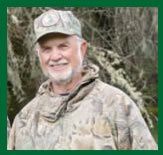Fall Turkey Hunting
by Terry Knight
The California fall wild turkey season opens on November
14. The season runs through November 29 and the limit is one
bird of either sex for the season. As in the past, WU will open
a number of properties to fall turkey hunting and the hunting
should be excellent.
As in the past, WU will open
a number of properties to fall turkey hunting and the hunting
should be excellent.
Fall turkey hunting still hasn’t caught on among California hunters. Many of the hunters are concentrating on waterfowl, quail or pheasants. But for those few dedicated turkey hunters the fall season can be as exciting as the spring season.
Slightly different tactics are used during the fall season. The turkeys don’t respond to a call the same as they do in the spring. Rarely will you hear a gobble and when you do, the tom really has little interest in you. Most of the birds taken during the fall season are either young jakes or hens. The old gobblers tend to stay in small isolated flocks and are extremely shy.
Starting in October, the smaller flocks of turkeys will merge into one larger flock. In some areas it’s not unusual to see as many as 100 birds in one flock. Getting within shotgun range of this many birds can be difficult. In fact, even locating a flock of turkeys in the fall can be a challenge. They will often find an isolated canyon where there is food and water and will spend the entire winter there. Because turkeys are in large flocks during the fall months, they tend to leave signs of their presence. Turkeys feed on seeds, acorns and insects and they obtain them by scratching. A flock of 25 turkeys will often dig up large areas under oak trees. Once you find these areas there is an excellent chance the flock is nearby.
Another method that veteran hunters use to locate turkeys is to hike and glass the hillsides with binoculars. It’s not unusual to see a flock of turkeys feeding in open glades. As the weather turns colder, turkeys require more food and they spend more time feeding.
While there is very little gobbling during the fall, turkeys are still quite vocal. They yelp, cluck, chirp and peep while feeding. They do this to maintain communication with the flock. If a young bird wanders away from the flock it will often make a high pitched whistle sound. It’s called the “kee-kee.” Usually the older hens will respond with a loud yelp.
Once you have located a flock of turkeys or seen fresh sign, be in the area well before daylight. The birds will fly down from the roost trees at first light. At this time you will hear a lot of yelping and clucking as the flock reassembles.
When feeding, the flock tends to move in the same direction. They can also cover a lot of ground in a short time. One successful method is to try and get ahead of the feeding flock. Set up against a tree and start making a series of soft yelps. Often a younger bird will leave the flock and come to you.
Another method is to scatter the flock. Once scattered, turkeys will try and regroup, the same as quail. After scattering the flock, set up and start calling. Use loud yelps and clucks to draw the birds to you. Often you will have an entire flock of several dozen birds came charging right up to you. Here, you have to be careful to select an isolated bird to prevent from killing more than one bird with a single shot.
One advantage that fall turkey hunters have is that they can hunt until sunset and that last hour of shooting time can be very effective. Turkeys will fly to the roost tree just before dark. Normally late in the afternoon a flock will meander towards the roost tree and then assemble just before they fly up. Locate the roost tree and set up about 50 yards away. As the birds approach make a few soft clucks and putts. Often this will draw a bird or two to you. Roost trees can be identified by feathers and droppings at the base of the tree. Unless disturbed, turkeys will generally use the same tree over and over again.
When it comes to selecting a call for fall turkey hunting, the box call is far and away the easiest to use. However, many of the experienced hunters prefer a diaphragm call.
Remember, as in spring turkey hunting, you have to be completely camouflaged and remain perfectly still. More birds are spooked by movement than by bad calling.
